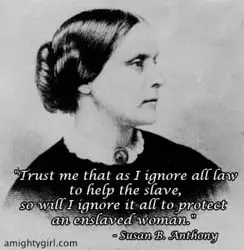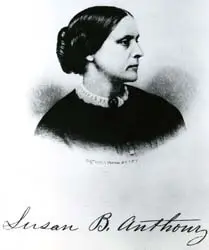Susan B. Anthony
 Susan B. Anthony played a major part in getting women the right to vote as well as other major roles and freedoms for women in the United States. Her Quaker family background helped her in her life and in moving what she believed was right forward due to her strong stand on morals and justice. Her family was heavily involved in the anti-slavery movement at the time.
Susan B. Anthony played a major part in getting women the right to vote as well as other major roles and freedoms for women in the United States. Her Quaker family background helped her in her life and in moving what she believed was right forward due to her strong stand on morals and justice. Her family was heavily involved in the anti-slavery movement at the time.

Anthony was a teacher for fifteen years and then became involved in the temperance movement with Elizabeth Cady Stanton in 1852. She had previously been involved in the abolitionist movement, traveling and lecturing around the country. She met angry mobs, face to face as they opposed her idea of freedom for the slaves. She very quickly made the decision to devote her life to the cause of helping women achieve freedoms in the country.

Susan B. Anthony took the same passion that she held with abolition to the fight for the right for women to vote and to achieve some of the same rights that were held by men. Stanton and Anthony organized the Women’s National Loyal League in 1863 to petition and support the 13th Amendment to the Constitution which outlawed slavery. They continued to campaign for full rights for women as citizens, no matter what their race.

When the 14th and 15th Amendments were passed, the women in the movement, including Anthony and Stanton were very disappointed. Women were not included in either of these Amendments. Anthony began publishing a newspaper called The Revolution in 1868, which focused on the many racial injustices that were happening. Anthony’s publication brought to the attention of the American people the actions that continued in prejudice and hate, including lynchings (hangings).

 In 1846, Anthony was only 26 years old, but was hired for a position a Canajoharie Academy as the head of the girls’ department. In 1853 Anthony met at a state teachers’ convention and called for better pay for women, for women to have a voice at the convention and for the admission of women into the professions.
In 1846, Anthony was only 26 years old, but was hired for a position a Canajoharie Academy as the head of the girls’ department. In 1853 Anthony met at a state teachers’ convention and called for better pay for women, for women to have a voice at the convention and for the admission of women into the professions.
She continued to rally this cry at a number of conventions around the country and promoted equal education for all in colleges and universities, no matter what the race or gender. By the 1890’s, Anthony was a member of Rochester’s State Industrial School trustees and campaigned for equal treatment and coeducation opportunities for girls and boys. Her efforts brought such an awareness and pledges that in 1900, the University allowed women to be admitted.

Anthony used her newspaper publication to advocate fair working conditions, an 8 hour work day, equal pay for equal work and policies to buy American goods instead of foreign goods. Her ability to meet with other women in the printing industry brought about the formation of the Workingwomen’s Association. Since women, at that time, were not allowed to join the men’s labor unions, this new group held the power of the women. As President of the Central Association office, she drew guidelines to accomplish many of the working standards that are used in business today.

She continued to work for the women’s movement to encourage the right to vote. Anthony campaigned across the country and, when she and other members tried to ‘vote’ they were arrested in Rochester, NY. Her continued efforts for the rights of women allowed her to get 10,000 signatures to make a change in the Constitution. When she showed up in 1877, the members of Congress laughed at her. She showed up at every Congress from 1869 to 1906 to demand attention to the suffrage movement. Her voice was also included in addressing some of the antiquated laws regarding women’s property rights.

The two suffrage organizations for women merged to become the National American Woman Suffrage Association in 1887. Stanton was the president with Anthony being the vice-president. Their presence was becoming a powerful force across the country and in 1893 Anthony attended the International Council of Women that was being held in Chicago at the World’s Fair.



